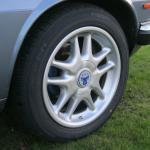New technical note: Should I add coolant sealant to my classic Jaguar XJS?
The short answer = NO!- 8th May 2015
- Technical
- Posted by kwecars
- No comments yet
We strongly recommend you read this technical note BEFORE adding coolant sealant to your classic Jaguar XJS. We’ve had several cases where the consequences have caused severe (and expensive to repair) damage.
In the note we explain how sealants work and describe the complex process we’ve devised to flush it out.
We also give advice on what you should do if you have a coolant leak – a must read for all classic Jaguar drivers.
https://www.kwecars.com/coolant-sealants/#.VUs5PdNVhBc
- 17th April 2015
- Technical
- Posted by kwecars
- No comments yet
Are Kevlar-reinforced replacement coolant hoses good enough to use in your classic Jaguar XJS? Based on our experience, we’d have to say no. So which hoses are best to use? And what’s important to consider when fitting them?
Find out what KWE recommends for coolant and fuel hoses in our new technical note on the website:
Coolant and Fuel Hoses
- 9th March 2015
- Technical
- Posted by kwecars
- 2 Comments
We often get asked which modern tyres are best for the Jaguar XJS and XJ saloon, so we’ve written a new technical note on the subject for our website.

Many XJS owners try very hard to source the tyres originally specified by Jaguar in the handbook, however, in our experience, we find that fitting a modern equivalent can greatly improve the handling. No need to pay over the odds for big name brands either! Find out more about our recommendations here:
https://www.kwecars.com/tyre-types-and-sizes-for-the-xjs-and-xj-saloons/#.VPmVWWSsWgM

- 28th November 2014
- Technical
- Posted by kwecars
- No comments yet
We’ve recently posted a note within our website’s tech centre all about waterless coolants. To visit this page, click here.

- 17th October 2014
- News, Technical
- Posted by kwecars
- 19 Comments
Engine oil viscosity is a measure of how runny it is, thus indicating its ability to coat and protect metal bearing surfaces from rubbing together metal-to-metal. Oil viscosity is quantified by a number, usually from 0 (very thin) to 90 (very thick). But this viscosity is inversely proportional to temperature, so hot oil is runnier and less able to protect big gaps as found in older engine designs, and cold oil is heavy and sluggish, draining some engine power and again reducing protection. So a fixed-grade oil has to be thick enough to protect the engine at maximum temperature but this means it will be very thick at cold temperatures, making the engine very hard to start. Cold climate drivers sometimes have to resort to heating the engine with a paraffin heater before they can be started!

Many